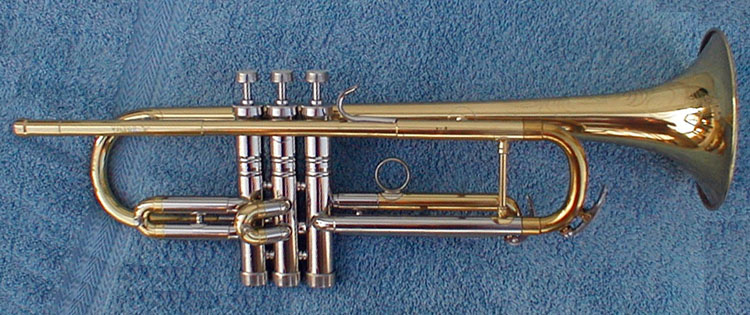Conn 6B Victor "Early Model"

Date: 1956. Owned by Allan Kamfonik
The "Early" model 6B victor is different from the later model in many ways, to the point te two versions are almost entirely different instruments. The 6B has bottom spring valves, a fixed 3rd slide ring, a "normal" wrap and probably the bore is a different taper. The 6B Victor "early" model was produced from late 1955 to 1957 and has a #1 bore (0.438").
How to tell a 6A Victor long cornet and a 6B Victor trumpet apart? The differences are quite subtle, but you should be able to tell if you know what you are looking for. All models for which there is both a long cornet and a trumpet (6A/6B, 10A/10B, 28A/38B) have a letter "A" or "B" stamped on the mouthpiece receiver. An "A" indicates a cornet leadpipe, a "B" indicates a trumpet leadpipe. The second way is to look at where the leadpipe widens out to accomodate the main tuning slide. On a trumpet this happens directly after the leadpipe finger hook, on a long cornet about an inch further down the leadpipe from the fingerhook. See picture.
Also see the 6B Victor "Late Model".
Allan Kamfonik, the owner of the pictured instrument, had this to say about his 1956 6B Victor:
Big volume and full like a Connstellation with the big bell, but a little more traditional sounding (not much). With my Bach 2½C mouthpiece,
it was absolutely teutonic. With my Curry 5C, bright, clear, and very penetrating. The valves, bottom sprung with the conical shaped springs, are clean, fast, light, and quiet. The best I've ever played on except
for a King Symphony I had a while back (which had the best valves of all time, but played very sharp). I much prefer this one to the Connstellations I've had. And it runs rings around the 18B and the two
22Bs I've had. The 18B sounded too much like a cornet, and the 22Bs didn't have the big sound quality that this one has. (Much better quality
brass, much better construction, much better design all equals much better sound.) This stuff about how this is a lower end horn than the
Connstellation is pure nonsense. It's a pro, all the way. Upper register is just as easy and open. Not as much of an obvious lead horn sound, but it can
sizzle like crazy if you need it to with the right mouthpiece. And, yes, it's LOUD if you push it and oh so lyrical and sensitive when you back off.
This is a more versatile horn than the Connstellation, I think. Better for me, anyway. Has a more brassy sizzle than a Bach or Olds, but still can sound
very legit with the right mpc. Very colorful and very versatile.
What Conn said in 1957:
Scientific design with acoustical qualities similar to the Connstellation
38B... exactly the same in every respect as the 10B Victor except for the
bell, which is high quality brass instead of Coprion. Clickless crysteel
valves with bottom spring give fast, postive, quiet action. Length 21¾",
weight 2 lbs. 13 oz. Bell diameter 5 1/8". Outfit includes handsome new Victor
case, music lyre and correct mouthpiece.
Highly polished brass, beautiful nickel trim, protected by longer lasting,
acid resistant LUSTRE-CONN finish.